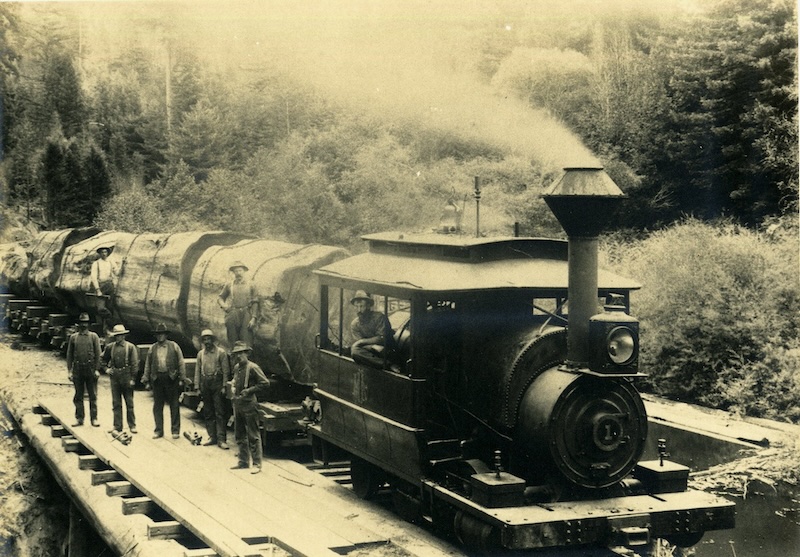Nannie Escola was a beloved school teacher in the community who was one of the local founding historians aiding the Kelley House Museum when it was created 50 years ago. The woman loved to read the Mendocino Beacon, then excerpt and index topics she was interested in.
One of the topics she loved was railroads, and here are some of her tidbits from 10/6/1877 to 12/10/1938. Since railroads served logging camps, a lot of timber history got included. I perused 60 pages of notes to glean these facts.

Mendocino Lumber Company Locomotive Engine Number One, 1900. Image shows loggers and engineer posing with four enormous redwood log sections on rail cars. This locomotive was one of four identical ones made in 1880 by the Baldwin Locomotive Works in Philadelphia, Pennsylvania, and shipped to San Francisco. It first became Number One of the Park and Ocean Railroad and ran the length of Golden Gate Park and north to the Cliff House. Engine Number One arrived in Mendocino on July 21, 1900, and tugged cars loaded with logs until retired from service in 1923. (Photograph by F. J. Chapman, Gift of Verda Wakerley.)
December 15, 1877: Mendocino Lumber Company is going to put in a locomotive to haul cars (of lumber) from the mill to the (shipping) point instead of using horses. July 31, 1880: The men at Jarvis’ Two Log Camp have struck for higher wages of $5.00 a month. The Company refused to pay so the men quit.
April 9, 1881: Mill closed for a month because a saw broke. (Replacement blades were hard to find). September 9, 1881: Forest fires ran through the logging camps on the south side of Big River to Burke’s (railroad) Tie Camp near the Ukiah Road and 1,300 ties burned.
April 30, 1887: The Lumber Company planned to run five oxen teams this season. (Railroads may have been expanding but oxen were cheaper.) November 20, 1887: Fourteen head of cattle were sold to Caspar Lumber Company. One weighed 2,200 pounds. (Lumberman ate LOTS of beef in their cookhouse meals).
December 7, 1889: The mill shut down until a means of sawdust disposal is found. The Fish Commissioner will not allow any more sawdust to be dumped in Big River. February 1, 1890: The mill started after a six month shutdown. A sawdust burner has been built to consume the sawdust.
May 6, 1893: The mill is putting in a sprinkler system to save about 25% on insurance rates. January 3, 1895: The mill lowered wages by 20% when they discovered they had been paying more than other mills and they were operating at a loss.
Ox teams were on their way out for pulling logs. July 21, 1900: Mendocino Lumber Company has purchased a 17 ton locomotive and loaded it on a lighter (boat) to be taken up river. August 25, 1900: A photographer went up to the woods to take pictures of the new locomotive as it made its first trip. The smallest log it pulled was eight feet in diameter.
January 12, 1901: Nathaniel Smith caught 70 nice salmon in a net and is selling them for 20 cents each. (You can bet the cookhouses bought some). December 27, 1902: Turkey, trimmings and $2.50 was given to each member of the crew at Perkins Logging Camp.
Flood! March 17, 1907: Several hundred logs were swept into the sea. At Perkins Camp many cabins were flooded and only the stack of the locomotive could be seen. Water was eight feet above the flat. (There was 60” of rain that season) February 5, 1921 Mill wages were lowered seven cents an hour. The men did not grumble as a work shortage exists. Again, on July 16, 1921: Mill wages were cut five cents an hour.
Nannie’s notebooks are a great way to learn more about local history in the Kelley House archives.
The Kelley House Museum is open from 11AM to 3PM Friday through Sunday. If you have a question for the curator, reach out to curator@kelleyhousemuseum.org to make an appointment. Walking tours of the historic district depart from the Kelley House regularly.